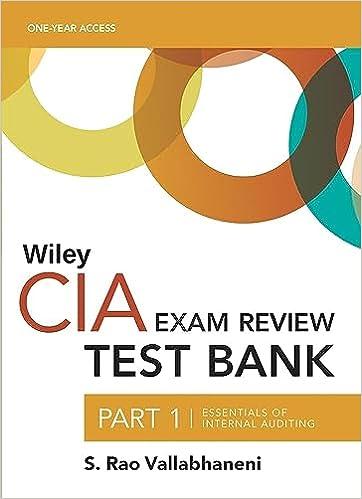Question
Beaver Company manufactures coffee tables and uses an activity minusbased costing system to allocate all manufacturing conversion costs. Each coffee tables consists of 30 separate
Beaver Company manufactures coffee tables and uses an activity minusbased costing system to allocate all manufacturing conversion costs. Each coffee tables consists of 30 separate parts totaling $260 in direct materials, and requires 33 hours of machine time to produce. Additional information follows:
| Activity | Allocation Base | Cost Allocation Rate | |
| Materials handling | Number of parts | $1.00 per part | |
| Machining | Machine hours | $3.00 per machine hour | |
| Assembling | Number of parts | $ 5.00 part | |
| Packaging | Number of finished units | $6.00 per finished unit |
What is the cost of assembling per coffee table?
A.$10
B.$150
C.$18
D.$30





Overcost
Undercoast
Willitte Pharmaceuticals manufactures an over-the-counter allergy medication called Breathe. Willitte is trying to Willitte's controller, Sandy DeRidder, has just returned from a conference on ABC. She asks Kyle Yaman, win market share from Sudafed and Tylenol. The company has developed several different Breathe products tailored to specific markets. For example, the company sells large commercial containers of 1,000 capsules to health-care facilities and travel packs of 20 capsules to shops in airports, train stations, and hotels supervisor of the Breathe product line, to help her develop an ABC system. DeRidder and Yaman identify the following activities, related costs, and cost allocation bases: (Click the icon to view the information.) Read the requirements Requirement 1. Detee the formula, then compute the cost allocation rate for each activity. (Round your answers to the nearest whole dollar. Abbreviations used: Mat-Materials, QA-Quality assurance) Activity cost allocation rate Mat handling Packaging QA Requirement 2. Use the activity-based cost allocation rates to compute the indirect cost of each unit of the commercial containers and the travel packs. (Hnt: Compute the total activity costs allocated to each product line and per kilo | per hour per sample -| then compute the cost per unit.) (Round the cost per unit to the nearest cent.) Commercial Container Travel Pack Estimated Indirect Allocation Estimated Quantity Activity Costs Activity Materials handling Packaging Quality assurance Total indirect costs Base 180,000 Kilos 410,000 Machine hours 113,000 Samples 703,000 of Allocation Base 18,000 kilos 2,500 hours 1,000 samples The commercial-container Breathe product line had a total weight of 8,127 kilos, used 1,500 machine hours, and required 210 samples. The travel-pack line had a total weight of 6,047 kilos, used 500 machine hours, and required 310 samples. Willitte produced 3,000 commercial containers of Breathe and 62,500 travel packs. Requirement 2. Use the activity-based cost allocation rates to compute the indirect cost of each unit of the commercial containers and the travel packs. (Hint: Compute the total activity costs allocated to each product line and then compute the cost per unit.) (Round the cost per unit to the nearest cent.) Commercial Container Travel Pack Materials handling Packaging Quality assurance Total indirect costs Number of units Indirect activity cost per unit Requirement 3. The company's original single-allocation-based cost system allocated indirect costs to products at $350 per machine hour. Compute the total indirect costs allocated to the commercial containers and to the travel packs under the original system. Then compute the indirect cost per unit for each product. Indirect cost Product allocated Commercial Travel Now compute the indirect cost per unit for each product under the original single-allocation-base system. (Round the cost per unit to the nearest cent.) Commercial Container Travel Pack Total indirect costs allocated Commercial Container Travel Pack Total indirect costs allocated Number of units Indirect cost per unit Requirement 4. Compare the activity-based costs per unit to the costs from the original system. How have the unit costs changed? Explain why the costs changed as they did The original system The original system allocated the commercial containers and the travel packs However, commercial containers V. The ABC system
Step by Step Solution
There are 3 Steps involved in it
Step: 1

Get Instant Access to Expert-Tailored Solutions
See step-by-step solutions with expert insights and AI powered tools for academic success
Step: 2

Step: 3

Ace Your Homework with AI
Get the answers you need in no time with our AI-driven, step-by-step assistance
Get Started


